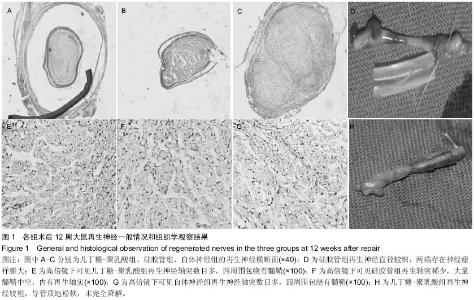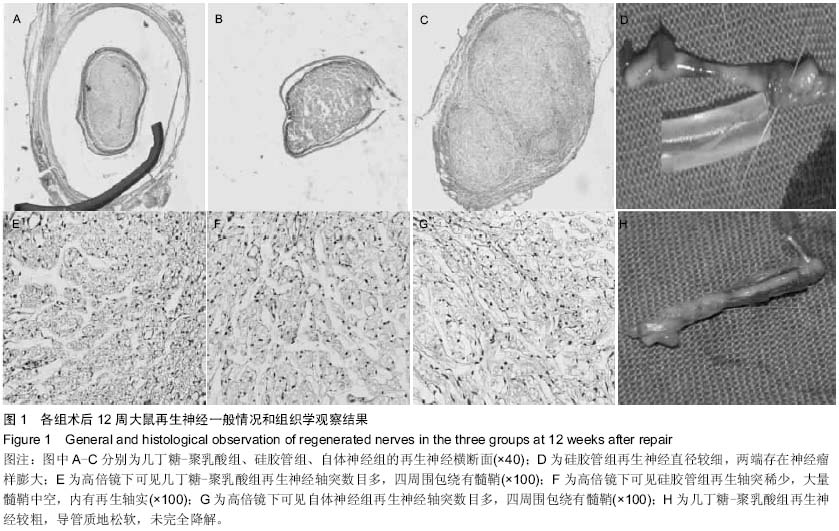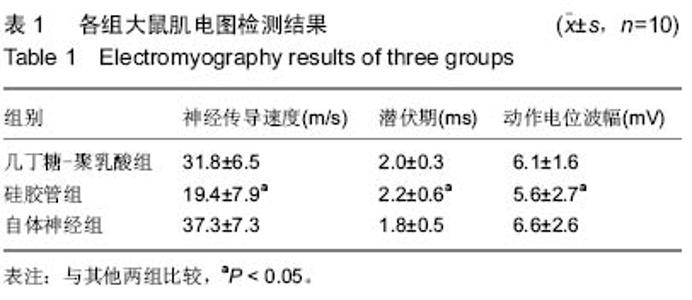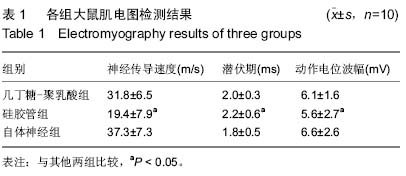| [1] 刘勇.几丁糖/聚乙烯醇神经导管修复周围神经缺损的实验研究[D].第二军医大学,2011.
[2] 蒋良福,劳杰,何继银,等.几丁糖胶原复合膜及激活态雪旺细胞修复周围神经缺损的实验研究[J].中华手外科杂志,2005,21(3): 172-174.
[3] 赵文,张志愿,孙坚,等.碳纳米管增强型天然复合材料神经导管修复大鼠副神经缺损[J].中国组织工程研究与临床康复,2009, 13(47):9236-9240.
[4] Shen H,Shen ZL,Zhang PH,et al.Ciliary neurotrophic factor-coated polylactic-polyglycolic acid chitosan nerve conduit promotes peripheral nerve regeneration in canine tibial nerve defect repair.J Biomed Mater Res B Appl Biomater. 2010;95B(1):161-170.
[5] Park SC,Oh SH,Seo TB,et al.Ultrasound-stimulated peripheral nerve regeneration within asymmetrically porous PLGA/Pluronic F127 nerve guide conduit.J Biomed Mater Res B Appl Biomater.2010;94B(2):359-366.
[6] 李强,伍亚民,李民,等.梭形双通道桥接管的研制及其桥接大鼠坐骨神经缺损的研究[J].中华创伤杂志,2004,20(4):230-233.
[7] 魏欣,劳杰,顾玉东,等.几丁糖-胶原复合膜促进周围神经再生的实验研究[J].上海医学,2001,24(9):534-537.
[8] 蒋良福.激活态雪旺细胞与几丁糖-胶原膜修复周围神经缺损的实验研究[D].复旦大学,2006.
[9] 刘勇,侯春林,林浩东,等.几丁糖复合聚乙烯醇神经导管修复大鼠坐骨神经损[J].中华显微外科杂志,2011,34(4):297-300.
[10] 张家胜.胶原-几丁糖复合生物材料研制及其修复神经缺损的实验研究[D].复旦大学,2001.DOI:10.7666/d.y415755.
[11] 张玉波,伍亚民,杨恒文,等.神经生长因子促再生周围神经血管生成的实验研究[J].中国矫形外科杂志,2005,13(18):1410-1412.
[12] 匡勇.几丁糖神经导管修复周围神经缺损的实验研究[D].第二军医大学,1998.
[13] 董红让,徐永年,黄继锋,等.聚乳酸/神经生长因子缓释导管修复周围神经缺损实验研究[J].中国临床解剖学杂志,2003,21(5): 482-485.
[14] 李志跃,李际才,赵群,等.聚乳酸聚羟基乙酸共聚物三维神经导管修复周围神经缺损[J].中国组织工程研究与临床康复,2010, 14(34):6313-6318.
[15] 李政,王伟.NGF/PLGA复合神经导管修复大鼠周围神经缺损的实验研究[J].中国康复医学杂志,2007,22(3):234-237,封3.
[16] 程文俊,徐永年,黄继锋,等.外消旋聚乳酸/神经生长因子复合导管修复大鼠坐骨神经缺损的量效作用[J].中华手外科杂志,2004, 20(4):237-239.
[17] 刘勇,侯春林,林浩东,等.静电纺纳米聚乳酸己内酮共聚物导管修复周围神经缺损的实验研究[J].中华手外科杂志,2011,27(4): 227-230.
[18] 孙焕伟,张铁慧,由欣岩,等.不同浓度许旺细胞与聚乳酸-聚羟基乙酸共聚物修复损伤周围神经的比较[J].中国组织工程研究, 2014,18(47):7579-7584.
[19] 沈尊理,沈华,张菁,等.睫状神经营养因子涂层的聚羟基乙酸聚乳酸神经导管修复犬胫神经缺损[J].中华显微外科杂志,2006, 29(5):347-349,插图5-4.
[20] 林慧鑫,张振伟.复合他克莫司聚乳酸-乙醇酸缓释导管修复大鼠胫神经缺损[J].中国组织工程研究,2012,16(12):2099-2104.
[21] 王文,蔡锦方,曹学成,等.聚乳酸导管内注入神经生长因子-聚乳酸/聚乙醇酸微囊修复周围神经缺损[J].中国组织工程研究与临床康复,2007,11(1):78-81,89,插1.
[22] 王敏,杨志焕,潘君,等.甲状腺激素人工神经桥接大鼠坐骨神经缺损的组织学观察[J].中国修复重建外科杂志,2005,19(11): 882-886.
[23] 钟荣国,李志跃,李际才,等.聚乳酸与聚羟基乙酸共聚物三维神经导管内微丝直径对周围神经缺损修复的影响[J].中华实验外科杂志,2010,27(1):108-110.
[24] 谢峰,李青峰,赵林森,等.新型复合生物材料导管修复大鼠周围神经缺损的实验研究[J].中华整形外科杂志,2005,21(4):295-298.
[25] Hsieh SC,Tang CM,Huang WT,et al.Comparison between two different methods of immobilizing NGF in poly(DL-lactic acid-co-glycolic acid) conduit for peripheral nerve regeneration by EDC/NHS/MES and genipin.J Biomed Mater Res A.2011;99A(4):576-585.
[26] 段永畅,田广永,郑伟,等.载NGF海藻酸凝胶-聚乳酸复合导管修复兔面神经缺损实验研究[J].中国临床解剖学杂志,2014,32(2): 189-191.
[27] 尚剑,Yuan Shao-hui.可降解聚乳酸导管与骨髓基质干细胞源性许旺细胞构建组织工程化神经[J].中国组织工程研究与临床康复,2008,12(27):5377-5380.
[28] 张伟才,黄继锋,严琼娇,等.PNGF导管复合骨髓间充质干细胞修复大鼠12 mm坐骨神经缺损[J].中国临床解剖学杂志,2014, 32(3):325-329.
[29] 董红让,徐达传.外消旋聚乳酸/神经生长因子复合导管对失神经肌萎缩的早期作用[J].中国组织工程研究与临床康复,2009, 13(21):4017-4021.
[30] Gao Z,Luo X,Li N,et al.Application of Amniotic Extracellular Matrix Nerve Conduit with Biological Material in the Peripheral Nerve Defect in vivo[C].//Advanced Research on Material Science, Environmental Science and Computer Science. 2011:171-174.
[31] Nakajima Y,Nishiura Y,Hara Y,et al.Simultaneous gradual lengthening of proximal and distal nerve stumps for repair of chronic peripheral nerve defect in rats.Hand Surg. 2012;17(1): 1-11.
[32] 林慧鑫,张振伟.FK506/PGLA缓释导管修复大鼠胫神经缺损的实验研究[C].//中华医学会手外科分会中南地区第四届手外科学术研讨会论文集,2011:12-13.
[33] 毕擎,夏冰,万智勇,等.一种新的生物材料-海藻酸盐修复长距离周围神经缺损的实验研究[J].中华急诊医学杂志,2003,12(7): 457-459.
|



